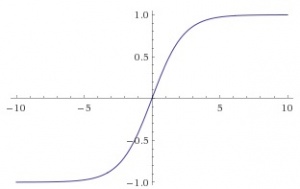Difference between revisions of "RuyTune"
GerdIsenberg (talk | contribs) |
GerdIsenberg (talk | contribs) |
||
| Line 12: | Line 12: | ||
* N is the number of test positions. | * N is the number of test positions. | ||
* R<span style="vertical-align: sub;">i</span> is the result of the game corresponding to position i; '''-1'''* for black win, '''0''' for draw and '''+1''' for white win. | * R<span style="vertical-align: sub;">i</span> is the result of the game corresponding to position i; '''-1'''* for black win, '''0''' for draw and '''+1''' for white win. | ||
| − | * q<span style="vertical-align: sub;">i</span> is corresponding to position i, the [[Score|value]] returned by the chess engine evaluation function. (Computing the gradient on the [[Quiescence Search|QS]] is a waste of time - it is much faster to run the QS saving the [[Principal | + | * q<span style="vertical-align: sub;">i</span> is corresponding to position i, the [[Score|value]] returned by the chess engine evaluation function. (Computing the gradient on the [[Quiescence Search|QS]] is a waste of time - it is much faster to run the QS saving the [[Principal Variation|PV]] and then compute the gradient using the evaluation function of the end-of-PV position - and not worry too much about the fact that tweaking the evaluation function could result in a different position being picked <ref>[http://www.talkchess.com/forum/viewtopic.php?t=64189&start=36 Re: Texel tuning method question] by [[Álvaro Begué]], [[CCC]], June 07, 2017</ref>). |
* [https://en.wikipedia.org/wiki/Sigmoid_function Sigmoid] is implemented by [https://en.wikipedia.org/wiki/Hyperbolic_function hyperbolic tangent] to convert [[Centipawns|centipawn scores]] into an expected result in [-1,1]. | * [https://en.wikipedia.org/wiki/Sigmoid_function Sigmoid] is implemented by [https://en.wikipedia.org/wiki/Hyperbolic_function hyperbolic tangent] to convert [[Centipawns|centipawn scores]] into an expected result in [-1,1]. | ||
<span style="font-size:120%;">Sigmoid(s) = tanh(0.0043s)</span> | <span style="font-size:120%;">Sigmoid(s) = tanh(0.0043s)</span> | ||
Revision as of 14:43, 25 October 2018
Home * Automated Tuning * RuyTune
RuyTune,
an open source framework for tuning evaluation function parameters, written by Álvaro Begué in C++, released on Bitbucket [2] as introduced in November 2016 [3]. RuyTune applies logistic regression using a limited-memory BFGS, a quasi-Newton method that approximates the Broyden–Fletcher–Goldfarb–Shanno algorithm with limited amount of memory. It uses the libLBFGS library [4] along with reverse-mode automatic differentiation and requires that the evaluation function is converted to a C++ template function where the score type is a template parameter, and a database of quiescent positions with associated results [5].
Method
The function to minimize the mean squared error of the prediction is:
where:
- N is the number of test positions.
- Ri is the result of the game corresponding to position i; -1* for black win, 0 for draw and +1 for white win.
- qi is corresponding to position i, the value returned by the chess engine evaluation function. (Computing the gradient on the QS is a waste of time - it is much faster to run the QS saving the PV and then compute the gradient using the evaluation function of the end-of-PV position - and not worry too much about the fact that tweaking the evaluation function could result in a different position being picked [6]).
- Sigmoid is implemented by hyperbolic tangent to convert centipawn scores into an expected result in [-1,1].
Sigmoid(s) = tanh(0.0043s)
See also
Forum Posts
- A database for learning evaluation functions by Álvaro Begué, CCC, October 28, 2016
- C++ code for tuning evaluation function parameters by Álvaro Begué, CCC, November 10, 2016
- Re: Texel tuning method question by Peter Österlund, CCC, June 07, 2017
- Re: Texel tuning method question by Álvaro Begué, CCC, June 07, 2017
External Links
References
- ↑ tanh(0.43s) , s=-10 to 10 pawnunit plot by Wolfram Alpha
- ↑ alonamaloh / ruy_tune — Bitbucket
- ↑ C++ code for tuning evaluation function parameters by Álvaro Begué, CCC, November 10, 2016
- ↑ libLBFGS: L-BFGS library written in C
- ↑ A database for learning evaluation functions by Álvaro Begué, CCC, October 28, 2016
- ↑ Re: Texel tuning method question by Álvaro Begué, CCC, June 07, 2017

